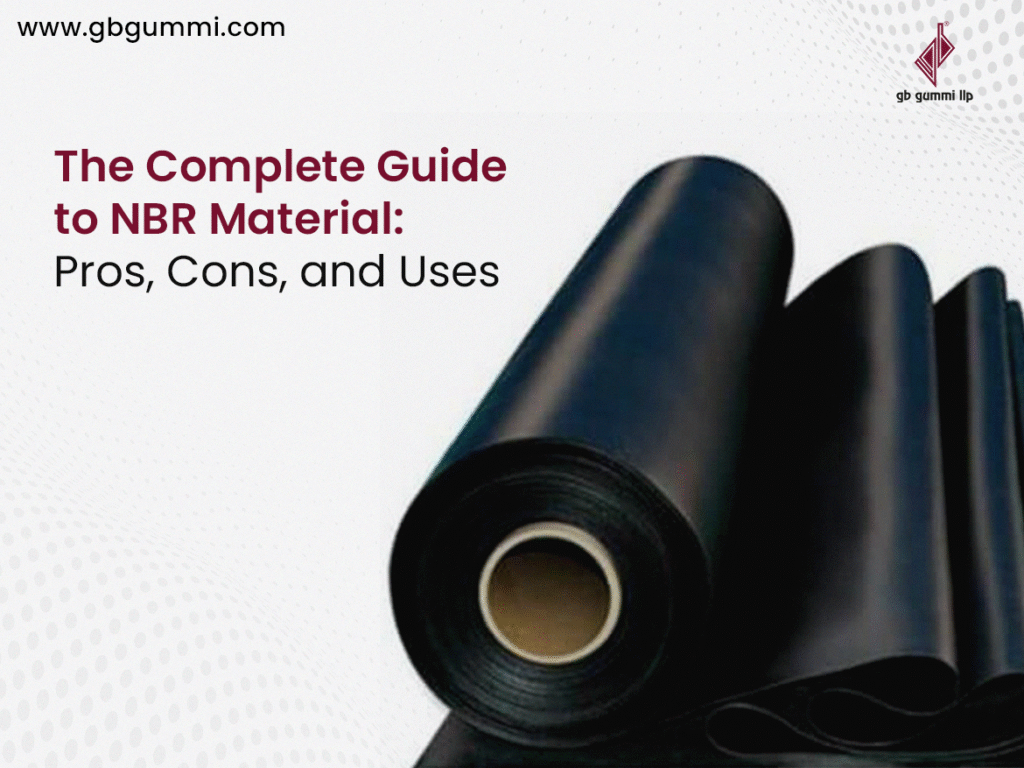From fuel lines to surgical gloves, modern industry relies on one unsung hero, NBR or Nitrile Butadiene Rubber. Often working behind the scenes, this synthetic rubber shows up where durability, resistance, and performance matter most.
But here’s the rub (pun intended): picking the wrong rubber can lead to costly breakdowns, unsafe equipment, and compliance nightmares. If you’re in automotive, oil & gas, manufacturing, or industrial design, you already know how much hinges on the right elastomer.
And that’s where NBR material comes in, a smart, reliable choice for harsh conditions and demanding applications.
In this blog, we will discuss what makes NBR a hero – its strengths, its caveats, and why it’s one of the most widely used synthetic rubbers in the world today.
What Is NBR Material?
Nitrile Butadiene Rubber (NBR) is a synthetic copolymer formed by polymerizing acrylonitrile (ACN) and butadiene. It’s also known in the industry by other names like Buna-N or simply nitrile rubber.
What sets NBR material apart is its ability to hold up in environments where other rubbers would fail, especially those involving petroleum-based substances. Over the years, it has become the material of choice for a wide variety of applications that demand durability and reliability in the face of heat, pressure, and chemical exposure.
Depending on the ACN content, NBR’s oil resistance can be fine-tuned, but more on that in a minute. You can find it in everything from automotive fuel hoses to non-latex disposa
ble gloves, thanks to its unique ability to survive environments that would degrade ordinary rubber.
One of the key reasons behind NBR’s superior performance is the vulcanization process. Just like natural rubber vulcanization, NBR undergoes a chemical treatment using heat and sulfur (or other curatives) to create cross-links between its polymer chains. This process significantly enhances the rubber’s tensile strength, elasticity, abrasion resistance, and thermal stability.
The result of the natural rubber vulcanization process is a durable, oil-resistant elastomer that holds up under extreme conditions, ideal for seals, hoses, gloves, and countless high-performance applications.
Understanding the Properties of NBR Material
The physical and chemical characteristics of NBR make it one of the m
ost adaptable and reliable materials for sealing and fluid-resistant applications.
Its most notable property is its resistance to oils, greases, fuels, and many industrial chemicals. This feature alone has made it a staple in the automotive, aerospace, and manufacturing sectors.
Temperature performance is another strong suit. Most grades of NBR material remain functional across a range of -40°C to 108°C, allowing for use in both cold environments and moderate heat.
Its tensile strength and abrasion resistance further enhance its suitability for dynamic applications like hoses, belts, and gaskets, where physical wear and movement are constant.
Additionally, NBR material offers moderate resistance to compression set, which means it retains its shape well under pressure over time. This is especially valuable in sealing applications, where long-term durability is essential.
What Makes NBR Material Unique?
The secret sauce? Acrylonitrile content. The percentage of acrylonitrile in the polymer backbone governs everything from flexibility to fuel resistance.
Lower ACN (18–30%) = Better flexibility, lower temperature resistance
Higher ACN (36–50%) = Better oil and fuel resistance, lower elasticity
Most general-use applications use a 33% ACN blend for balanced performance.
Unlike other polymers, NBR material also holds up well despite minor compositional tweaks — meaning you get consistent results batch after batch.
Want even better strength and heat resistance? Step into the upgraded versions:
- HNBR (Hydrogenated NBR): Ideal for high-heat, chemically exposed environments. Think automotive air conditioning systems, oil field exploration, and industrial sealing.
- XNBR (Carboxylated NBR): Adds abrasion resistance and tensile strength — perfect for belts, gaskets, and seals under high stress.
These enhanced variants are used in highly regulated sectors like aviation, marine fuel systems, and heavy-duty machinery.
Where Is NBR Material Used? Common Applications That Rely on Its Strength
In the automotive sector, NBR material is a mainstay. It’s found in everything from fuel hoses and gaskets to O-rings, V-belts, and transmission seals.
These components often come into contact with motor oil, transmission fluids, or gasoline – conditions where NBR’s resistance and resilience prove critical. It is used widely by rubber sheet manufacturers to manufacture durable, functional and liquid-resistant rubber sheets for applications across industries.
In aerospace, NBR components are used to create self-sealing fuel tanks, hydraulic hoses, and grommets, thanks to their ability to perform at high altitudes and across variable temperatures.
The healthcare industry also leans heavily on nitrile for disposable gloves and lab accessories, not just for its puncture resistance, but because it’s less likely to cause allergic reactions compared to latex.
Industrial uses include adhesives, footwear, synthetic leather, cable jackets, printer rollers, and even sponges.
Nitrile Butadiene Rubber is also widely used in the manufacture of oil-resistant seals and gaskets across marine, oil & gas, and manufacturing industries, where equipment needs to remain leak-free even under corrosive or high-pressure conditions.
Why GB Gummi Remains a Trusted Partner
For companies, including OEMs, maintenance teams, and rubber sheet manufacturers seeking the right balance of durability, chemical resistance, and cost-efficiency, NBR material remains an unmatched option. It may not be the flashiest polymer on the market, but it’s a workhorse: dependable, adaptable, and engineered to last.
As industries evolve and environmental demands grow more complex, materials like NBR continue to prove their worth in both established and emerging applications.
If you’re looking for expert guidance on the right elastomeric material for your next product or system, we can help. At GB Gummi, our experienced rubber specialists excel at developing custom NBR-based components that meet stringent performance and compliance standards.
Ready to engineer reliability into your product? Contact us today to explore tailored NBR material solutions for your business.

